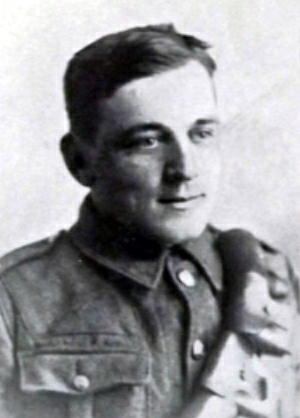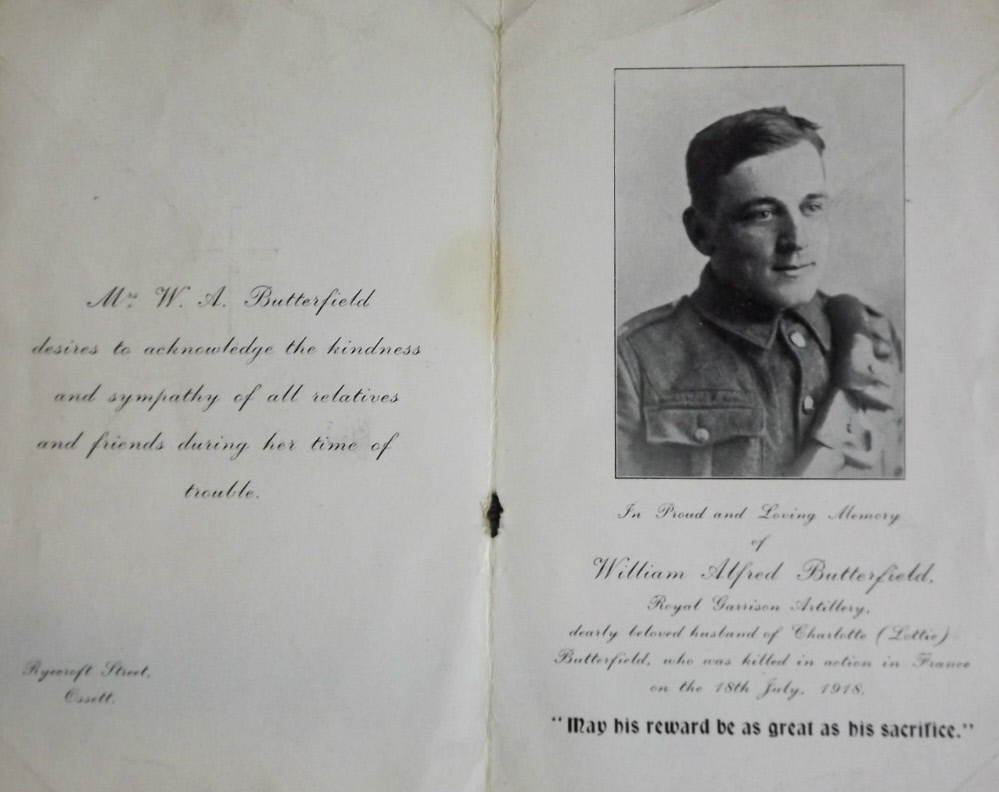
William Alfred Butterfield was born in Lebrina, Tasmania in 1890, the sixth born of eight children, including five boys, all born in Tasmania to John and Mary Butterfield between 1880 and 1894. All of the children were British citizens by parentage. Their father, John was born in Bradford in 1852 and their mother, Mary was born in Pudsey in 1853. John and Mary may be the John Butterfield and Mary Durns who married in Bradford district in December 1880.
On Wednesday, 9th October 1895, this advertisement appeared in the “Launceston Examiner” in Tasmania, suggesting that the Butterfield family were selling up and preparing to return to England:
“Monday October 28th – Valuable Property Near Lebrina – We have received instructions from Mr John Butterfield, who is leaving for England, to sell by auction at their mart, Charles-street, on the above date at 12 o’clock, Farm property, of 148 acres, in the vicinity of the Lebrina Railway Station (Scottsdale Line); 38 acres are in crop, 40 acres in grass, sub-divided into seven paddocks, fenced with post and rail fencing. Buildings consist of cottage of four rooms and out-kitchen, six-stalled stable, three cart sheds, barn 60ft by 26ft (two floors, brick foundation), men’s hut, fowl house. Orchard of 1 acre, coming into full bearing. Water: This property is the best watered in the district, four permanent creeks; a well 23ft deep, with pump, near the house for domestic purposes. Garden: There is a choice selection of small fruits and flowers. With the above will be sold the following stock and implement: Two good horses, assorted harness, farm dray, plough, set of harrows, horse hoe, Sampson’s tree puller, horse works for three horses, chaff cutter, Avery’s weighing machine, pine ladder (24ft), wheelbarrow, and useful lot of farming and other tools. Crops as fallow: 8 acres wheat, 15 acres peas, 7 acres oats, 3 acres grass seed. The whole to be sold as a going concern; affords a splendid opening for an energetic man wishing to engage in agricultural pursuits.”
In 1901, John, a woollen rag merchant, and his wife Mary and their children were living at Dearden Street, Ossett. Mary Butterfield died in late 1903 aged 52 and in early 1904 John married 34 year-old Eliza Ann Broadhead. In 1911, William Alfred and his brother, Walter were living with their father and stepmother at 12, Wesley Street, Ossett. John and his second wife Eliza Ann now have a child, Sarah Jane, born in Ossett in 1905. Another child had been born to the couple, but had died before April 1911. At this time William Butterfield was working as a tuner of weaving looms in a cloth mill.
William Butterfield married Charlotte Bennett in the Dewsbury Registration District in the June quarter of 1915, but it appears that the couple had no children. William’s widow Charlotte remarried in 1928 to Albert E. Gatenby in the Dewsbury Registration District.
It is not known when William Butterfield joined the Royal Garrison Artillery, since his service record has not survived. However, his CWGC record tells us that he was with the 188th Siege Battery at the time of his death on the 18th July 1918. The 188th Siege Battery arrived in France on the 30th October 1916 and in 1918 was part of the RGA 53rd (Mixed) Brigade with six 9.2″ Howitzers.
RGA Siege Batteries were equipped with heavy howitzers, sending large calibre high explosive shells in high trajectory, plunging fire. The usual armaments were 6 inch, 8 inch and 9.2 inch howitzers, although some had huge railway or road-mounted 12 inch howitzers. As British artillery tactics developed, the Siege Batteries were most often employed in destroying or neutralising the enemy artillery, as well as putting destructive fire down on strongpoints, dumps, store, roads and railways behind enemy lines.
A short obituary appeared in the “Wakefield Express” on the 27th July 1918:
“GUNNER WM. A. BUTTERFIELD, of Ossett, has been killed in action in France. He was killed instantaneously by the bursting of an enemy shell. His home was at Ryecroft Street, and he leaves a widow but no children. Before enlisting he was employed at Westfield Mills. He was an active worker in connexion with the Central Ossett Baptist Church and Sunday School. He was a member and past President of the Christian Endeavour Society there and for some years taught in the Sunday School. Shortly before he joined up he had qualified as a lay preacher, and in this capacity had served at Rothwell, Crigglestone, Ardsley and elsewhere in the district.”
Gunner William Butterfield’s army service record has not survived, but he was awarded the British and Victory medals, but not the 1914-15 Star indicating that he did not serve overseas before the 31st December 1915.

Above: A British 9.2″ Howitzer on the Western Front during WW1.
Gunner Butterfield was killed in action, aged 27, on the 18th July 1918, and he is buried at grave reference II. D. 2. at the Hagle Dump Cemetery, 1 Ieper, West-Vlaanderen, Belgium. Hagle Dump Cemetery is 7.5 Kms west of Ieper town centre on the Sint Pietersstraat, a road leading from the N308 Poperingseweg, connecting Ieper to Poperinge.
Elverdinge was behind the Allied front line throughout the war, and Hospital Farm and Ferme-Olivier Cemeteries, both in the commune, were used in the earlier years for Commonwealth burials.
The cemetery, which was begun in April 1918, during the Battles of Lys, was named after a nearby stores dump. It was used by fighting units and field ambulances until the following October and was enlarged after the Armistice when more than 200 graves were brought into Plots III and IV from the battlefields of the Ypres Salient and the following cemetery:-
Brielen Military Cemetery, which was close to the South side of Brielen village, contained the graves of 31 French soldiers, 16 from the United Kingdom and four Canadian, and was used from April 1915 to September 1917.
The graves of 26 American soldiers, who fell in July-September 1918, and two French soldiers were removed to other burials grounds. Hagle Dump Cemetery contains 437 Commonwealth burials of the First World War, 139 of which are unidentified.
A memorial service was held in Ossett for Gunner William Alfred Butterfield after his death and quite recently a copy of the memorial card that was handed out during the church service appeared on eBay. This near 100 year-old memorial card is shown below:
